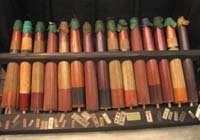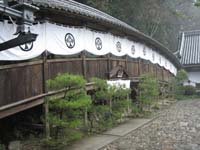IN THE ABSENCE OF THE WHITE DEER
 Yesterday despite the rain we went to one of my favorite nearby holy places, Ishiyamadera (where Murasaki Shikibu stayed for a while and wrote part of Genji), to see if the famed plum blossoms were out. They weren't, so we postponed the plum-blossom visit for another week and decided instead to travel a bit further along the Seto River, a very impressive jade-green burly rush that shoulders itself from Lake Biwa to the sea, providing water to Kyoto and Osaka and all towns in between.
Yesterday despite the rain we went to one of my favorite nearby holy places, Ishiyamadera (where Murasaki Shikibu stayed for a while and wrote part of Genji), to see if the famed plum blossoms were out. They weren't, so we postponed the plum-blossom visit for another week and decided instead to travel a bit further along the Seto River, a very impressive jade-green burly rush that shoulders itself from Lake Biwa to the sea, providing water to Kyoto and Osaka and all towns in between.We were headed for the place where Kobo Daishi (aka Kukai) stood at the Seto riverside 1100 years or so ago and saw a strange light shining up on the mountain. Just as he decided to go up there and investigate, a white deer appeared and offered to transport him to the place. Up he went, and there founded the small temple Tachiki-Kannon, where there is now a statue of Kobo Daishi riding a deer and where a famous 12-headed Kannon now resides.
When we got to the very same starting spot though, and stood by the river looking up the steep mountainside, no white deer appeared. Rather there were 700 high stone steps to bear us up to the tree-shrouded top, with conveniently shrined stopping places along the switchbacks where gasping pilgrims both younger and elder can pause and pay their breathtaking respects to the holiness that got them this far and pray for the fortitude to continue.

When at last we got to the top we were in pretty good shape for a couple of elders, though parched from gasping, so we went right away to get out of the rain and have some of the free tea that has been on offer there for just that reason for over a thousand years, then sat and sipped beside the big bronze tea-water cauldron in the small open-sided tea space and viewed the temple precincts. It was very like traveling back in time.
Because it is rather confined in size and sort of out of the way, and because there are 700 steps up to it, Tachiki-Kannon is not much visited in comparison to Ishiyamadera (there were maybe a dozen visitors when we were there), so change is slow. And since time is change, it was interesting in detail. I love places (and people) that truly honor their own age. Definitely worth the trip.
Heading back down the steep steps was a lot easier, like life when you get past 40.
When I get my breath back I'll tell you about the great place we went next.


















6 comments:
"I love places (and people) that truly honor their own age"
But now I must rest awhile after following you and Echo up all those steps (in my mind's eye)
This 76 year old would rather have been tranported to the top by the white deer.
All the way up, I was tossing off white deer prayers left and right, but I'm no Kobo Daishi. My legs had to be the white deer.
I visited Ishiyamadera last year at the begining of April (before the sakura) and saw the plum blossoms, lovely. It was a quiet day with few visitors, and I felt I could have abandoned the world below, and stayed up there among the trees in contemplation. Vey tempting!
Seta?
I really like going with you and Echo on your excursions! I will never to get to Japan, and alsways wanted to see it, and now, through you, I am!
Mary Lou, it's very nice to have you along!
Post a Comment